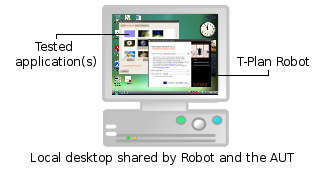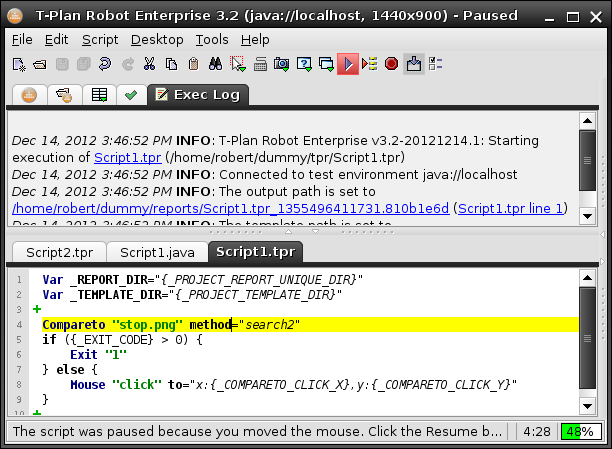Last update: 13 December
2012
Contents:
1. Introduction
2. Setting Up
3. Automation
1. Introduction
T-Plan Robot Enterprise version 3.2 introduced support of automation of
applications displayed on the local
desktop. This means that Robot and one or more Applications Under Test (AUT)
run on the same local desktop. The automation is of course not
limited to the AUT and it may perform any desktop action that a
regular user can do.
 Advantages:
Advantages:
- Single machine scenario with no need of another computer
and/or OS.
- It relies just on the local Java SE installation and it
requires no other software to be installed. This allows to use
Robot in non-intrusive scenarios where the target system may not
be modified. In an extremely isolated scenario, the file based
distributions of Robot and Java can be copied to an external
media(CD, DVD, USB drive) and executed from there to keep the
SUT free of any installation.
- Fast & easy operation.
Limitations:
- Record & replay is supported only on MS Windows 2000 or
newer (since version 3.5).
- Test script relying on the Local
Desktop connection can not be started remotely through
a terminal such as telnet or rsh. Use the VNC Server connection for
such scenarios instead.
2. Setting Up
Local desktop automation is supported over two connection types:
- The Local Desktop
connection relies on the local Java SE installation. There are
no other dependencies. To connect simply select the connection
in the Login
Dialog and hit Connect.
- The local desktop can be also
automated over a locally running VNC Server:
- Install a supported VNC Server or enable
the system built-in VNC access (Ubuntu, Mac OS X)
- Select the VNC Server connection type
in the Login
Dialog and connect to localhost.
If the server is configured to use a different port than the
standard 5900 one use localhost:<port>,
for example localhost:5901.
The Local Desktop
connection is the preferred one. It is in general more reliable than
the VNC server and it can type non-English characters (see the keyboard support). The Local Desktop
connection is also typically faster in terms of screen polling. The
VNC server may provide better screen performance if it is attached
directly to the video driver, such as for example UltraVNC with
the Mirror Driver or TightVNC
with the DFMirage driver.
On a successful connection Robot starts up with the Workflow
chart displayed instead of the desktop viewer and the application
title will indicate the connection (java://localhost
or rfb://localhost:5900).
3. Automation
To connect to the local desktop from a test script use the Connect command (TPR scripts) or
the connect()
method (Java test scripts). The argument URL must be in form of
either "java://localhost"
(Local Desktop connection type) or "rfb://localhost" (VNC Server).
For example, the following command/method call will connect you to
the local desktop using the Local Desktop connection:
TPR test scripts:
Connect java://localhost
Java test
scripts: connect("java://localhost");
To connect to the local desktop using a VNC server running on the
standard port of 5900:
TPR test scripts:
Connect rfb://localhost
Java test
scripts: connect("rfb://localhost");
The local desktop automation process differs from the remote one.
When Robot needs to work with the local screen it must hide the GUI first. In the test
script development phase it applies to situations when the user
chooses to perform image comparison, to take a screen shot, to
define a screen location or a rectangle, to create a new template
image or to perform Component Capture.
Similarly when a script starts to execute, the GUI gets hidden and
it is not restored until the scripts finishes. To pause the script
execution move the mouse.
This will suspend the script and restore the GUI as follows:
While a script is paused the tool bar contains an extra  button. It
allows to switch the UI to a minimized layout which displays just
the script control tool bar buttons:
button. It
allows to switch the UI to a minimized layout which displays just
the script control tool bar buttons:
To go back to the full UI click the button again. The last selected
layout gets saved to the user preferences and used in the script
pause mode until the button gets toggled again.
To resume the script simply click the red blinking  Resume button or press F5. Avoid
changing of the AUT state or switching among applications while a
script is paused because the script may fail after you resume it. If
you need to do any such a task, bring the AUT to the front before
switching to Robot and resuming the script. This will ensure that
the AUT window will become the topmost one after Robot hides the
GUI.
Resume button or press F5. Avoid
changing of the AUT state or switching among applications while a
script is paused because the script may fail after you resume it. If
you need to do any such a task, bring the AUT to the front before
switching to Robot and resuming the script. This will ensure that
the AUT window will become the topmost one after Robot hides the
GUI.
IMPORTANT: Do not change the
OS keyboard layout while using the Local
Desktop connection. It maps the layout when the connection
is established and any later change may cause the test script press
invalid keys. To remap the keyboard disconnect and reconnect. This
may be performed even from a test script by a sequence of Disconnect and Connect commands (TPR format) or
the disconnect()
and connect()
methods (Java format).
Behavior of the local desktop connection can be customized in the Local
Desktop panel of the Preferences dialog. The options
allow to set the mouse sensitivity for the script pausing purposes
and the UI hiding behavior.
Compatibility between the Local
Desktop and VNC Server
connections is not explicitly guaranteed. A test script designed
against a local or remote VNC connection may or may not run
correctly with the Local Desktop. The following factors apply:
- The environments must match in terms of the OS and the desktop
parameters (screen resolution, color depth). If the desktop
parameters are different the template images may fail to compare
and you will have to recreate them or add new alternatives using
the Image Collections.
- The Local Desktop connection
supports a different set of keyboard keys. It can simulate a
press of only those keys that are available in the current
system keyboard layout. For example, if the computer uses the
United Kingdom (GB) keyboard layout, the dollar key ('$') is not
there. When Robot is instructed to press the key using the Press command it can't press it
directly because the physical key associated with this character
is not available. Robot in such a case uses the system clipboard
to paste the character
instead of pressing it on the keyboard. This will work well
where the character is being typed as part of a text. It will
however not work correctly where the AUT requires something like
"Press the $ key to continue"
and listens to the particular key press event.
Another difference is that while the VNC connection in general
supports just characters from the ASCII 7-bit character set, the
Local Desktop connection can transfer any national (UTF-8)
characters supported by the system clipboard. It may for example
type a Russian or Greek text. This allows to employ Robot for localization (l10n) or internationalization (i18n)
testing.
Version 3.5.2 extended the Exec command
to simplify work with local applications which are typically tested
over the Local Desktop connection. The basic pattern is that
the script starts a local application, tests it and closes it at the
script end. Example:
// Start
myapp.exe
nowait="true"
...
//
Test the application
//
Kill the application ('1' is ordinary number
of the )
kill="1"
 Advantages:
Advantages:
 button. It
allows to switch the UI to a minimized layout which displays just
the script control tool bar buttons:
button. It
allows to switch the UI to a minimized layout which displays just
the script control tool bar buttons:
 Resume button or press F5. Avoid
changing of the AUT state or switching among applications while a
script is paused because the script may fail after you resume it. If
you need to do any such a task, bring the AUT to the front before
switching to Robot and resuming the script. This will ensure that
the AUT window will become the topmost one after Robot hides the
GUI.
Resume button or press F5. Avoid
changing of the AUT state or switching among applications while a
script is paused because the script may fail after you resume it. If
you need to do any such a task, bring the AUT to the front before
switching to Robot and resuming the script. This will ensure that
the AUT window will become the topmost one after Robot hides the
GUI.